Iran is in the news again, as Americans have recently discovered that they are currently our eternal blood enemy. Mincing warmonger Lyndsay Graham was ready with handy charts to denounce the Persian Reich from the Senate floor. Mark Levin has spent the last few days on an internet jihad against anyone who questions that Muslims, marxists, and Nazis are basically the same thing, which is to say Iranians. Ted Cruz assured a somewhat skeptical Tucker Carlson that one can safely ignore those parts of the Bible proclaiming the Church to be the new Israel in favor of an even newer and more financially generous one, and that Christians are enjoined to fight on behalf of this secular socialist ethnostate against Iran, which has been three weeks away from developing a nuclear bomb for thirty years. Also gay rights and feminism!
Not since Yukio Mishima has a man of the right* held such an obsessive homoerotic fixation on the violent deaths of beautiful young men.
*the word ‘right’ stretching like Reed Richards.
All of this was fortunately met by an internet chorus of howling derision, which made for a problem for President Trump. His greatest strength is that he has an almost preternatural political savvy; his greatest weakness is that, like all boomers, he has been conditioned for seven decades to do whatever the TV tells him. Since the shills at Fox News thought bombing Iran was a great idea, and since Benjamin Netanyahu looked so sad that his son’s wedding got postponed due to all the Iranian missiles, he apparently thought he’d go ahead and take care of the vaguely-defined problem by dropping some bunker busters on them, then count on the internet to quickly move on, provided he could offer some remotely plausible pretext to do so. People want to think about ongoing wars even less than they want to participate in them, after all.
Did it work? It’s impossible to say, quite literally so, since, upon reflection, the whole thing seems a bit bizarre. Like most modern media content, it’s feels both overly scripted and still somehow incoherent, like there’s too many writers in the room, but they’re not talking to each other. Also, no one is buying it. The Weekend at Bernie’s presidency of Joe Biden was a great example; like Game of Thrones, the audience abandonment of suspension of disbelief was wholly apparent in real time on the internet, a fact to which the show runners were indifferent. As Martin Gurri pointed out, the public response to most media crises is not panic or anger, but ridicule, on the part of all but the most dull and docile segments of the population.
But if you’re a late Gen-Xer like myself, thinking of Iranian epic story arcs can only lead to one place, the greatest Persian who ever lived, Cyrus the Great…
… is what I would say if we weren’t talking about America, where of course there is exactly ONE Iranian legend worth talking about. Yes, you know him:
And yes, Hossein Khosrow Ali Vaziri- The Iron Sheik- was an actual Iranian. In an age where producers would use Italians as Indians and John Wayne as a Mongolian, Vaziri was actually born in a suburb of Tehran in 1942. His country was then known as the Imperial State of Iran, ruled over by the son of a previous usurping general, Reza Pahlavi. This would be the authoritarian modernizer so beloved of Western oil companies and the CIA.
The Shah, seen here in a file photo
Like most young Iranian boys, then and now, Vaziri was a huge fan of wrestling- the actual sport, not the scripted spectacle. Wrestling is a big deal in Iran, as it has been for thousands of years, a legacy of the Zoroastrian martial ethos from the days of the Achaemenids. Modern Iran is an Olympic wresting powerhouse, but the traditional forms and training methods are still popular as well. Vaziri’s father owned a zurkhaneh (gym) and as a youth the son idolized Gholamreza Takhti, a multiple-Olympic medalist at 87-97 kg freestyle. He trained hard to become a champion himself.
It’s difficult to find confirmation about the Sheik’s athletic achievements before he came to the US. It’s possible that he was the best high school wrestler in Iran, and that he came to the attention of the Shah during his mandatory army service, becoming a personal bodyguard. It’s also possible that he fled the country in 1968 due to his belief that the Shah had something to do with his hero Takhti’s controversial death. For whatever reason, like all foreigners, he came to Minnesota.
This was fortuitous, because the Midwest is justly famous for turning out corn-fed grappling monsters. As Matt Hughes of UFC fame noted in his autobiography, it’s the sport of choice (along with basketball) for rural, working-class boys- played indoors during the winter months with minimal equipment expenses. Vaziri fit right in, becoming a Greco-Roman AAU champion in 1971 at 180.5 lbs, then going on to work as a coach for the US Olympic Team in 1972 and 1976. But there wasn’t much of a living to be made competing legitimately in the sport on the professional level. A generation or so later, he might have followed the path of Hughes and so many other elite grapplers and entered MMA. But as it happened, several significant changes were occurring in the country at the same time that would serve to catapult him to fame and (somewhat ephemeral) fortune.
Minnesota is also known for fent-head civil rights icons and the spastic, twerking fruitcake mayors who love them.
First, he decided to become a professional wrestler. By the late 1970s, this meant almost exclusively “worked” events- which is to say scripted to one degree or another- the days of legitimate “shoots” having gone the way of vaudeville. It also meant joining a stable/promotion that would facilitate his career, and here again the future Sheik was fortunate. The acerbic (and quite ruthless) Verne Gagne, already a legend, was based out of Minnesota, and his camp would produce a host of legends- Ric Flair, Ricky “The Dragon” Steamboat, Bob Backlund, and many others were all there with Vaziri. Even for a national wrestling champion Gagne’s tutelage was brutal, but Vaziri learned the secrets of both selling a match and engaging with a crowd. Unlike in pure combat sports, where technical prowess can offset a dull personality, in professional wrestling, as with Roman gladiator fights, narrative is king. It’s drama first and foremost, in which viewers must be invested for it to work. This meant that Vaziri would need to become more than an athlete; he would need to metamorphose into a character. But what..?
Well, does he?
At the same time Vaziri was making his career transition, his native country was undergoing some changes as well. The liberal authoritarian Shah had modernized the country so quickly and thoroughly that he alienated large segments of the population, creating resistance among people of a wide range of political beliefs. Ultimately, a somewhat odd (from a Western perspective) coalition of young urban student radicals and hard-line rural Shia religious conservatives spearheaded a popular uprising against the Shah- and his main backers, Western petroleum interests and the CIA- in 1979. Since the 1950s the latter had made sure the spice flowed, helping to ensure the US the cheap energy it needed, regardless of how Iranians felt about the very uneven social changes and state repression they endured because of it. While things were still quite unsettled, a mob of students stormed the US embassy- this in response to news that the Carter administration would be granting asylum to the deposed Shah- a serious escalation coming almost certainly with the tacit support of elements of the emerging new regime, soon dominated by senior religious leaders called Ayatollahs. The sight of howling hordes of foreigners taking American government officials hostage enraged people across the US, the last in a series of humiliations Americans had endured throughout the miserable 1970s.
The media of the day was able to capitalize on this outpouring of emotion. Nightline came into being four days after the Iranian Hostage Crisis began that November- ABC needing something to compete with Johnny Carson’s Tonight Show- and showcased nightly updates on the situation and the response of the feckless Carter government. In June of 1980, the crisis still ongoing, Ted Turner launched CNN, featuring 24 hour news coverage for those willing to shell out for the innovative new cable TV services that would exponentially increase American media exposure. Night after night, Americans watched in bewildered impotence as furious exotics threatened to kill their countrymen, and the narrative was clear and consistent. These bizarre and treacherous people- if they weren’t working for the commies- were simply insane. Who could hate freedom like that, and denounce the best country on earth as the “Great Satan?” Lost on most were the complexities of the situation in Iran, as well as a fuller awareness of American involvement in the region, a story that would not present the US in a very positive light. It was enough to know that we were the good guys and they were the villains. They were easy to hate and so they were hated.
Is that Hulk Hogan on the right side?
Bringing all of this together was a young heir to a thriving but underexploited business badly in need of modernization. Vince McMahon Jr., from a broken home in rural North Carolina, went to work for his father’s wrestling company, but gradually realized that the then-dominant model of non-competing regional promotions was cheating the medium of its full potential. Taking over in 1982, McMahon bought out talent from competitors until he’d essentially established a national monopoly on professional wrestling, creating coast-to-coast broadcasting spectacles out of what had once been small-time productions often staged out of rodeo arenas and local gyms.
Gone were local toughs with beer guts and little in the way of showmanship. McMahon’s wrestlers were smoothly packaged artistic creations carefully marketed to appeal to national audiences. The muscles and the personalities were larger than life- and equally the product of various forms of chemistry. Of course, it would all get more extreme over time, but the basic elements were there from the start. There were the “faces”- the good guys, clean-cut types who generally represented aspects of American life viewers would see positively. Then there were “heels”- cheats, crazies, jerks, and of course, various evil foreigners. This latter element had been a staple of sports entertainment since the aforementioned days of the gladiators, but in America, with its complex attitudes towards foreign affairs and immigration, it made for especially compelling drama.
Ted DiBiase, “The Million Dollar Man,” was the prototypical ‘evil rich guy’ heel as well as being a sad reference point for the ravages of inflation.
Malevolent Germans and Japanese were passé by the early 80s, (for some reason no one seems to have thought of Viet Cong heels) but Iran presented wonderful new creative possibilities. It had the benefit of being a premade mass-media hate object with the added bonus of most Americans knowing almost nothing about it. Thus, Vaziri was uniquely placed to capitalize on all of these trends to become an all-time epic villain.
He bulked up. I’m not stating definitively that steroids were involved, but he went from wrestling in the AAU at 180 to a muscular billed weight of 258 in the WWF, at 37. He shaved his head and grew out a mustache that suggested he was prone to tying women to railroad tracks. Hilariously, his costume would feature an abaya and kheffiyah- Arab national dress. It would be as if a wrestler billed as The Killer Kanadian came through the ropes wearing a sombrero, shaking a pair of maracas. His ring name, the Iron Sheik, was also something more in line with Arab Sunni usage. Of course, Americans weren’t especially sensitive to such cultural nuances, then or now. For them, it was enough to understand that there was a big desert somewhere far away full of volatile brown people who had some inexplicable beef with Jews and freedom.
And the Sheik took to this perfectly. A natural showman and a born heel, he cultivated the persona of a hateful foreigner with nothing but utter contempt for the “stupid Americans” who packed shows to see him while screaming racial slurs and threats at him as he denigrated their country, all the while praising the Ayatollahs who had humiliated them. He had what in wrestling jargon is called “heat,” the ability to inspire vehement emotion in audiences. Everyone wanted to see him lose, but of course, the story required him first to be victorious.
Sheik’s manager was the great Classy Freddy Blassie.
The Sheik defeated all-American face Bob Backlund in 1983, becoming the WWF World Heavyweight Champion, which in turn set the stage for the arrival of the greatest champion of the golden era of pro wrestling. While Backlund’s persona was that of a small-town good guy, Floridian Terry Bollea’s Hulk Hogan was a creation made for the Age of Reagan. Charismatic, bombastic, and huge, Hogan was a walking allegory for the Gipper’s America. For originalist conservatives, his skullett evoked the dimly remembered legacy of Ben Franklin, while his physique- massive and glistening red like a Christmas ham- brought to mind the excess of abundance (or abundance of excess) that signified the 80s ethos of preening superiority. When seriously provoked in the ring he would enter “Hulkamania,” a kind of trancelike state of violent ecstasy that was essentially the physical instantiation of neoconservative social and foreign policy.
This is legitimately what Adam Kinzinger thinks he sounds like when addressing internet trolls.
Hogan took the title from the Sheik after an epic match and embarked on his own odyssey to superstardom, while the Sheik continued to be a draw, teaming up with evil Russian (actually a Croatian) Nikolai Volkoff as a tag team. He would feud with nemesis Sgt. Slaughter- a walking caricature of a drill sergeant complete with Bruce Campbell chin- always with the same gimmick of the foreigner who held the US in contempt. This would continue throughout the 80s until a seemingly minor mishap wholly derailed the Sheik’s career.
He made it onto GI Joe.
In 1987, while still a big name, the Sheik, along with fellow wrestler Hacksaw Jim Duggan, was pulled over while the latter was driving. Duggan was drunk and the Sheik was carrying a felony weight of cocaine. That they had committed crimes didn’t bother the fans and WWF so much as the fact that, per the storyline, Duggan and the Sheik were supposed to be blood enemies, not partying together. The most basic rule of professional wrestling is to never violate kayfabe, the industry term for manufactured drama according to established storylines and lore. This was taken extremely seriously at the time; a few years before, Hulk Hogan had almost been arrested after having been pulled over when his companions- The Wild Samoans- refused to break character and talk to the police normally, going, well, wild and prompting the cop to draw his firearm. The Sheik and Duggan were fired from the WWF as a result. Though brought back in a limited capacity shortly after, the glory days were over.
Kayfabe is an important concept, not merely for wrestling, but the wider worlds of media and politics. While the drama is needed to compel interest and sway sentiment, behind the scenes, paradoxically, everyone has to share a general consensus regarding desirable outcomes for the whole thing to work. Fighting is hard; pretending to fight is, in some ways, more challenging, because one must create an illusion of violence that looks real without endangering the other party. Wrestlers- often very large men performing acrobatic feats under stress and adrenaline- have to trust each other implicitly as they fake punch and body slam each other, because if they don’t, they’ll flinch and hesitate and the illusion will be broken.
The Sheik’s character was even more involved and ironic than the typical persona. He genuinely loved America, had married an American woman, and was what most would call a success story, happy and grateful in his adopted land. But in his mediated life, he became more famous than he ever could have been as his authentic self by playing the part of a swaggering, hateful foreigner allied to a hostile power. Americans loved him most when he gave them permission to hate him.
It’s possible that the Sheik’s character would have fallen off in any case. The end of the Cold War brought about new domestic and geopolitical realities. The earnestness of the Iron Sheik persona would have been out of place in the 90s and 2000s era wrestling scene, steeped in gray morality, irony, and self-aware meta-commentary. Vince McMahon, casting around for a new villain to epitomize the age, settled on himself, and entered the ring as his own self-insert avatar, “Mr. McMahon,” an overweening corporate tyrant of a type recognizable in the era of outsourcing and downsizing. His main enemy was Stone Cold Steve Austin, a denim-clad blue-collar beer-swilling Texan who regularly foiled the boss’s various schemes.
Like fellow mogul Roger Ailes, McMahon was a strong supporter of women in the workplace. It actually ended kind of badly…
But there was another contender who made for an intriguing foil for Mr. McMahon, a New York real estate developer and media whore who just happened to kayfabe-want to buy the WWE (McMahon having in the meantime lost a copyright suit vs. the World Wildlife Federation). Yes, Donald Trump made his own wrestling debut in 2007, where his machinations naturally culminated in a match-by-proxy between Trump and McMahon, the loser of which would be shaved bald in the ring in Wrestlemania 23. The significance of this I feel has never really been fully appreciated. If most people think of it, they recall the meme from the 2016 election, where a clip from the match of Trump clotheslining and pummeling McMahon was reworked with the CNN logo over the latter’s face. But a lot of other things had happened in the meantime.
The 80s tendency toward corporate consolidation- epitomized by McMahon’s empire- resulted in the Telecommunications Act of 1996, which essentially lifted nearly all restrictions on media outlet ownership. This had the predictable result of a few big companies coming to dominate news and entertainment. This general trend of deregulation also fueled the rampant financial speculation that would ultimately lead to the Great Recession. America’s continued involvement in the Middle East led to the costly debacle that was the War on Terror. At the same time however, a paradoxical and more anarchic force, the internet, was rising in prominence. For all the system’s pretensions to orderly dissemination of official, preferred narratives, a shadow world would emerge to challenge and critique the status quo, fueled by the serial fiascoes of late, decadent managerialism. Though of course, even (especially) here, the lines between organic and manufactured would always be a bit fuzzy.
People began noticing that while the drama in politics was partisan and acrimonious, behind the scenes their leaders seemed to agree with each other more than they differed. It wouldn’t be wrong to call it kayfabe, really. D and R cut promos for abortion or gay rights, then when the cameras aren’t rolling, they work hard to facilitate wars, immigration, and corporate malfeasance that no one wants but still somehow gets regardless of who’s in charge. The world of professional wrestling merely epitomizes a general culture of narrative-driven media spectacle constructed to entertain and communicate regime ideals into an easily digestible format, but it’s not especially different from what CNN does (Ted Turner would also found World Championship Wrestling to compete with McMahon). Trump is in many ways the first politician to fully grasp and adopt this as a method of rule. In many ways, “President Trump” is a character in the same sense as “Mr. McMahon,” a kind of prole ideal of what someone in the role ought to be. Behind the scenes, of course, there’s a canny politician who’s enjoyed no small amount of success translating narrative into actual power, much as the actual Vince McMahon is a successful businessman while playing a parody of himself on TV. He’s a far better storyteller than his rivals.
It never stops being funny, even though the real story is a bit more … nuanced.
It does complicate things, however, when one must interpret events of real life import in terms of their relationship to a narrative. Are Trump and Iran feuding in real life? Has he turned on Israel? Did any nuclear plants get wrecked? Did the various parties agree ahead of time to bomb each other’s vacant bases to get some compelling footage of explosions for the rubes watching Fox News? Is any of it real? Is it all kayfabe? It seems for the moment that the “War with Iran!!!” story arc has run its course, though if it proves a fan favorite one might expect to see a rubber match in the near future. I speculate, of course, but what choice is there?
If you’re skeptical that all of this is as significant as I’m describing it, consider that the upside-down woman in the above clip is Linda McMahon, wife of Vince and current Secretary of Education. The man piledriving her is mutilated psychopath Kane, who in his day job is Glenn Thomas Jacobs, Mayor of Knox County, Tennessee, widely considered a serious prospect for governor.
As for the Iron Sheik, things weren’t over for him. His decision to forgo a 401k in favor of piles of cocaine was a bold financial strategy, but ultimately unwise. He retired to Fayetteville, Georgia, which if you know anything about the area, is a very nice place in the sense that Cleveland is better than Detroit, and everyone in Fayette County counts his blessings that he’s at least avoided neighboring Clayton County. His daughter was murdered by her boyfriend and his wife left him. There were some very low points for the Sheik.
Come for Jonesboro’s quaint Fourth of July Parade, stay for the semi-accredited schools. Clayton County: We’re Still Better Than Macon!
But media once again gave him a chance at a new life. As with Macho Man Randy Savage, his actual personality had long since been replaced by his character, and he discovered that there was a perfect modern venue for unhinged, furious tirades- Twitter. Like most working-class foreigners, around half the words he knew in English were profanities, and once he discovered the Caps Lock key, it was open season on the internet. For the same reason, he subsequently became a favorite of podcasters big and small, and was able to launch a line of merchandise. In 2005, he was inducted into the WWE Hall of Fame. President Trump earned the same accolade in 2013.
Key takeaways here: Macho Man is the cream of the crop, and the cream always rises. As someone noted in the comments, it’s like an unethical medical experiment to see if steroids can cure cocaine addiction. Also, from what extradimensional space are those creamers emerging?
The Iron Sheik died in June of 2023 at the age of 81, having outlived a great number of his hard-living peers. His legacy lives on, however, as his management team has not let the Sheik’s passing stop the great man from continuing to post on X. The account still puts out gems, like the Sheik’s most significant contemporary feud, this time against French Canadian children’s cartoon character Caillou. Rest in peace Sheik, you’re a legend…
And f*** you, Caillou.





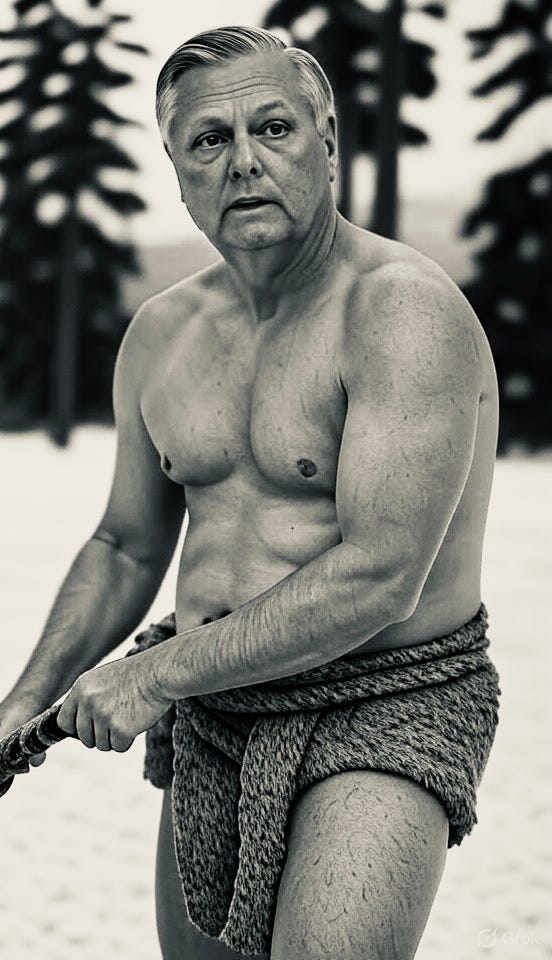
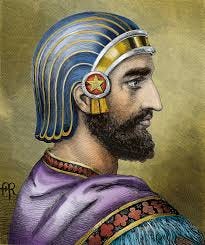


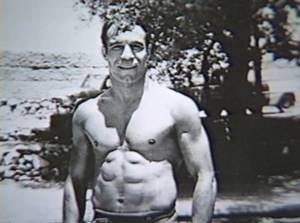

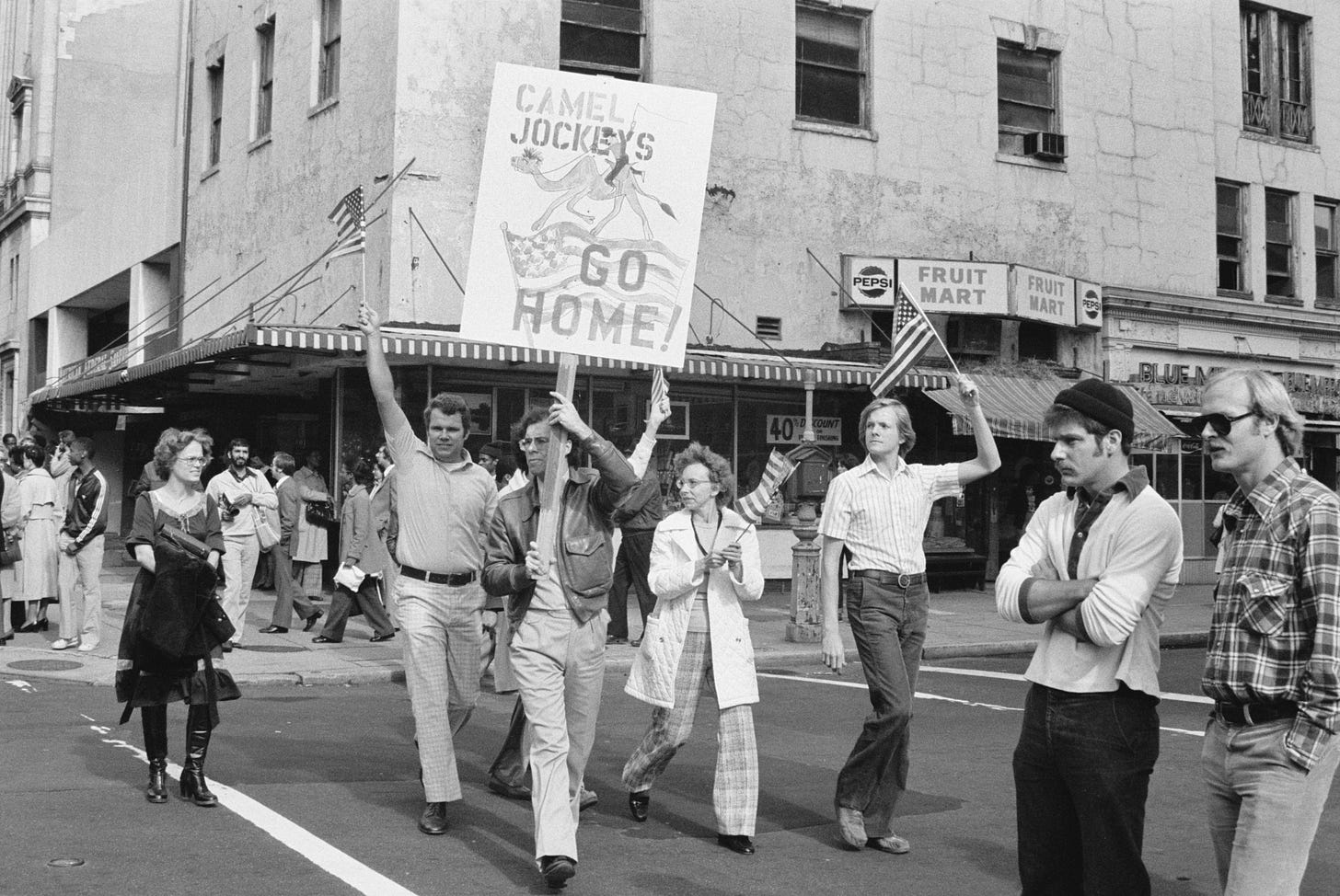
![Ted DiBiase showing off his Million Dollar Championship belt. [Photo courtesy of WWE.com] Ted DiBiase showing off his Million Dollar Championship belt. [Photo courtesy of WWE.com]](https://substackcdn.com/image/fetch/$s_!0HK8!,w_1456,c_limit,f_auto,q_auto:good,fl_progressive:steep/https%3A%2F%2Fsubstack-post-media.s3.amazonaws.com%2Fpublic%2Fimages%2F265a2072-89aa-4db2-a173-46d1e3f0bbec_1200x677.jpeg)
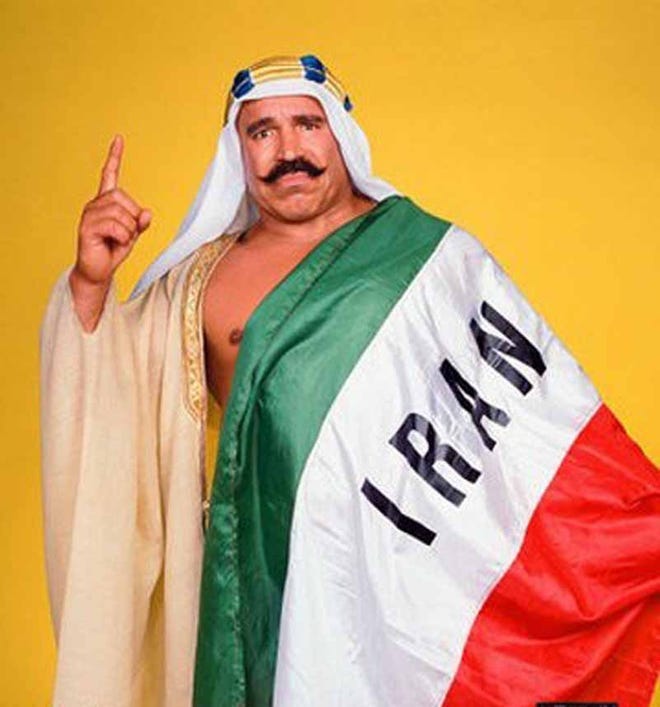
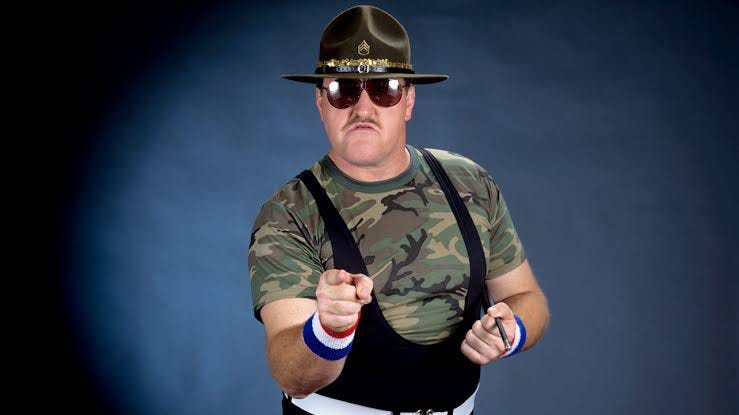


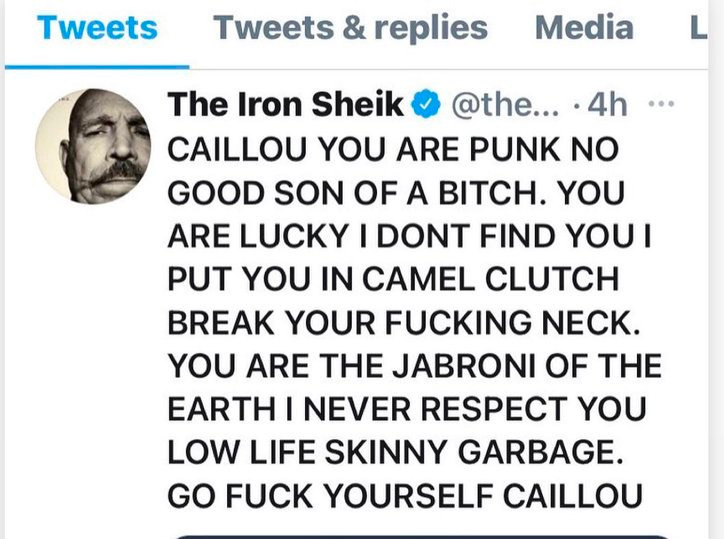

I laughed. I cried. It was better than CATS.
Thank you for closing with the Sheik from the top rope on Caillou - needed that today.
Brilliant, hilarious, and pointed. The experience of reading this is a series of switches between laughing out loud and muttering “damn” under my breath.
Rest in peace, Iron Sheik. We hardly knew you, which was always the point.